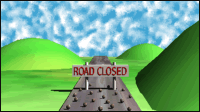Road Surface Dressing in the UK
Created | Updated Nov 14, 2008

In the summertime, when the roads of Britain are slowly melting in the heat of the blazing sun local government councils the length and breadth of the British Isles dispatch squads of labourers to scatter loose chippings over the highways and byways for which they are responsible.
Why Do they Do This?
Road surface dressing is basically achieved by applying a coating of molten bitumen with a layer of granite chippings spread over the top. Once laid, the surface is left for a while to bed down with the assistance (albeit unwittingly) of passing motorists. The remaining granite chippings should, ultimately, be swept up - although in practice they often aren't.
The Official Position
Surface dressing notionally increases the life of the road. The bitumen layer restores the waterproof surface of the road and prevents water from seeping into the base layers, where it might freeze and swell, causing potholes. Secondly, the chippings are supposed to increase surface friction. Finally, the whole process is meant to fill any minor cracks and imperfections, preventing costly surface failures.
What Really Happens
What actually happens is that councils don't do enough road maintenance. They often wait until the road surface has already started to break up, especially at the edges, and then try to make up by surface dressing. By this time it's too late, and all they are doing is hiding the potholes.
A Road User's Perspective
Loose chippings flay the paint off cars, and damage their protective underbody sealing. They are also flung up by the passing of cars at speed and chip windscreens, as well as getting stuck in tyre treads.
Bicycles and motorcycles become almost unridable on loose chippings. As an added bonus, when the potholes (disguised under a layer of stones) bend your wheels and cause you to fall off, the stones which are stuck in the bitumen take off large areas of skin - a phenomenon known as 'gravel rash'.
Finally, the process of laying the chippings often seems to involve closing roads just when they are likely to be used. For example, they generally seem to do coast roads on bank holiday weekends. Or at least they make a start, then park all the equipment and cone off large stretches of road and go away for a while.

